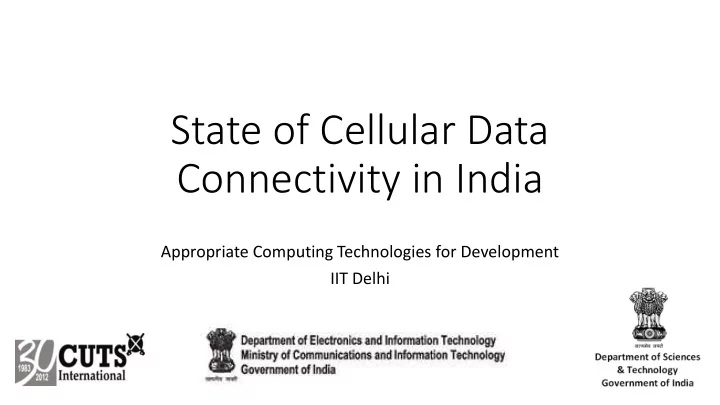

State of Cellular Data Connectivity in India Appropriate Computing Technologies for Development IIT Delhi Jun 2015
Internet access in India • Largest growth market, Digital India upswing, leapfrog in economic development assisted through ICTs • Barriers to Internet adoption • Relevant content and services • User capability • Affordability • Infrastructure availability and quality • Project scope • QoS obtained for mobile Internet => 2G/3G connectivity • Mix of rural, semi-urban, and urban locations • Understand current state of mobile Internet connectivity and any design issues • Findings prompt us towards the need for better QoS regulation
Measurements methodology
Data collection • 20 locations spanning rural, semi-urban, and urban areas in MP, Jharkhand, and Delhi • Field partners: PRADAN, Vikas Samvad, Air Jaldi, Gram Vaani • Data collected between 2013-2014
1. Availability • No rural • Wide variation in • Urban locations are locations had availability, most providers relatively more stable 3G access have below 80% availability than rural locations
2. Throughput (2G) • Advertised values range from 144Kbps (EDGE-1) to 256Kbps (EDGE-2, 3) • Very few locations approach within 75% of the advertised values • Fair bit of diversity across locations, despite high signal strengths ensured in location selection
2. Throughput (3G) • Advertised values range from 1.4Mbps (UMTS-1) to 2.1Mbps (UMTS-2, 3) • Less difference from advertised values than 2G • Yet, fair bit of diversity across locations, high deviation from advertised values
3. Latency • Interesting why a variation • Target roundtrip • Some providers are doing across locations exists latency required very well on latency within the same provider < 250ms (EDGE-3 and CDMA-1)
Other aspects we have studied • Page load times for websites • Hardly any meet the 5sec recommended PLT guidelines • Website design also matters: AFT/PLT ratios • Largely a function of latency • Latency depends on ISP interconnections, backhaul architecture, CDN presence • Security • EDGE-1 and EDGE-2 implement IP spoofing & stateful firewalls, EDGE-3 and CDMA-1 do not • Technology issues • Buffer sizes of 100-150KB are 10x the BDP in 2G, 2x in 3G • Connection stalls of up to 120sec occur in 40% of flows when signal strength dips often due to default modem settings • Mobile users in rural areas run into frequent deadspots with mean time between failure of 30min
Going forward • Lots of avenues for technology research • Regulatory issues • Framework for QoS regulation: Self reporting, third party auditing of measurements, nutrition labels, mandatory data disclosure • Stakeholders: CSOs, web companies, service providers, regulators • Economic models • Ownership: Community owned networks like Guifi in Spain • Extension: Social enterprises like Air Jaldi in India • Disruptive technology: OpenBTS related projects from UC Berkeley
Thanks! The ACT4D team Aaditeshwar Seth, Vinay Ribeiro, Huzur Saran: IIT Delhi Anirban Mahanti, Sebastian Ardon, Siput Triukose: NICTA Australia Zahir Koradia, Arvind Kumar Mahla: PhD students Rahul Nishant, Sameer Agarwal, Amitsingh Chandele, Arvind Subramanium, Sathyam Doraswamy: MTech students Asheesh Sharma, Manveen Kaur: Research Associates Rajesh Kumar, Suresh Mourya, Arun Kumar: Department staff aseth@cse.iitd.ernet.in
Recommend
More recommend